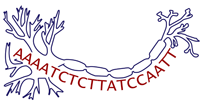The activity, organized by topics, is presented such that students progress from simpler to more complex database exploration. The topics expose students to human health-related databases as well as to databases for multiple species, which can be used for comparative genomics.
Sickle Cell Disease
6. 10% of the African population had the A nucleotide
Additional Resources
Sickle cell trait and malaria protection
About the 1000 Genomes Project
Genome Size
5. Human genome C-value = 3.50 pg
8. Acrida conica grasshopper C-value = 10.82 pg (it is bigger than the human genome)
9. Human genome base pairs = 3.50 x 0.978 x 109 = 3,423,000,000 bp (or 3,423 Mb)
A. conica genome base pairs = 10.82 x 0.978 x 109 = 10,581,960,000 bp (or 10,581.96 Mb)
Additional Resources
Genome size and organism complexity
Huntington’s Disease
5. HTT (huntingtin gene)
7. a) CAG
b) glutamine
c) 9 to 36
Additional Resources
How are human genes named?
Cystic Fibrosis
5. CFTR
8. CFTR encodes a protein involved in the transport of chloride ions.
Additional Resources
More on cystic fibrosis
What is the Gene Ontology?
Breast Cancer
5. RAD54L, CASP8, BARD1, PIK3CA, HMMR, NQO2, ESR1, RB1CC1, SLC22A1L, TSG101, ATM, KRAS, BRCA2, XRCC3, AKT1, RAD51A, PALB2, CDH1, TP53, PHB, PPM1D, BRIP1, CHEK2
Additional Resources
National Cancer Institute's Breast Cancer information
BRCA1
6. DNA repair, cell cycle checkpoint control, maintenance of genomic stability
11. Tumor suppressor, plays a role in transcription, DNA repair of double-stranded breaks, and recombination
12. Examples for “A BRCA1 mutation causes ____________.”
…damaged DNA to remain damaged and cause tumors.
...a decrease in a [nuclear phosphor]protein that prevents tumors.
…problems with transcribing what is encoded in the DNA.
13. Pan troglodytes (chimpanzee)
Macaca mulatta (Rhesus monkey)
Canis lupus familiaris (dog)
Bos taurus (cattle)
Mus musculus (house mouse)
Rattus norvegicus (Norway rat)
Gallus gallus (chicken)
Looking at the protein domains, we can see, for example, that the protein from chickens (G. gallus) contains many of the structural elements found in the human BRCA1 protein (from looking at the “Proteins” and the “Conserved Domains,” you can see that chickens have the BRCT_assoc (green domain), and BRCT (purple domains) that are shown in the human protein). Considering that these domains reflect protein regions that have specific functional properties, we can infer that the chicken protein might carry out many of the same functions as the human BRCA1 protein. Thus, even though we might not think of chickens as being susceptible to breast cancer, their cells still likely need the chicken version of the BRCA1 protein to carry out DNA damage and repair processes in much the same way the human BRCA1 protein fulfills these tasks in human cells. One could also think of BRCA1 more broadly as a “DNA repair” gene, instead of a “breast cancer” gene.
Additional Resources
More about "conserved sequences"
Additional bioinformatics/database problems from the National Center for Biotechnology Information



 Discovering the Genome
Discovering the Genome